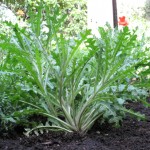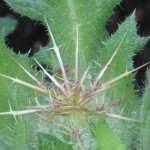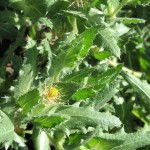Blessed Thistle
 |
 |
 |
Above: Three images of the blessed thistle (Cnicus benedictus). The low stature and unremarkable appearance of this plant belie its medieval reputation as a plague cure and a panacea. The lax stems and spiny, light green leaves are covered with a fine, white down; the spines that subtend the developing flowerhead are a protection against grazing animals. The yellow flowers of this annual thistle appear in July; once the seeds have set, the plant dies. Photographs by Corey Eilhardt.
The humble Cnicus benedictus, a plant of waste ground and stony soil native to the Mediterranean, was a medieval panacea whose reputation survived undiminished into the Renaissance. The sixteenth-century English herbalist John Gerard notes that this wild medicinal plant of southern Europe was “diligently cherished in gardens in these Northern parts.” Gerard also attests that the herb was known everywhere in Europe by the medieval Latin name Carduus benedictus; the common names by which it is known today preserve this designation: blessed or holy thistle in English, benedikten distel in German; chardon b??nit or chardon santo in French, cardo benedetto in Italian, cardo bendito in Spanish.
